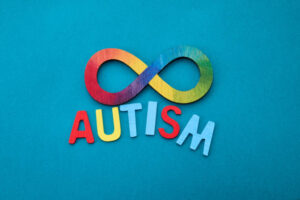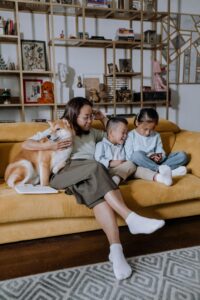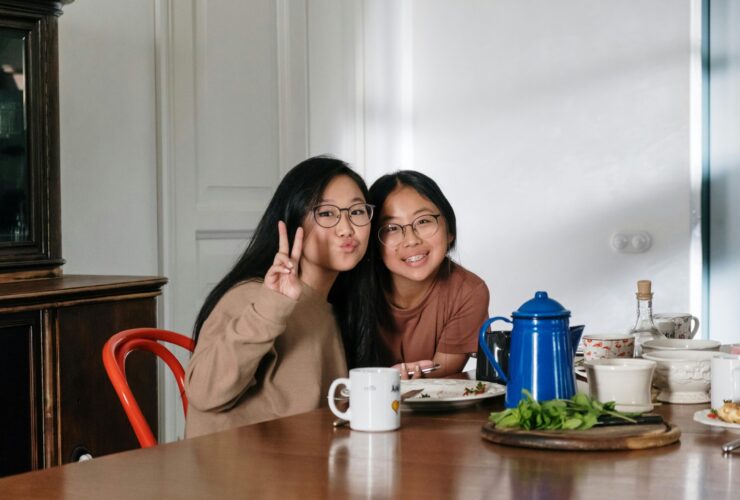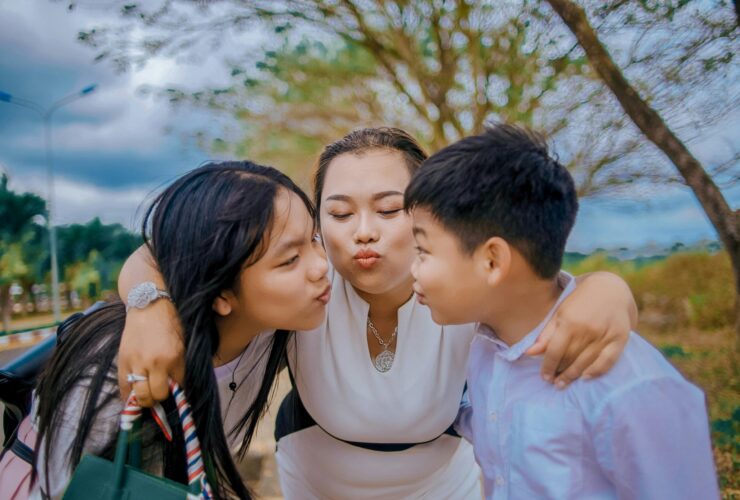Being Asian American and autistic means navigating two communities that don’t always understand or acknowledge each other. It means existing in spaces where cultural expectations around achievement, family honor, and “saving face” can clash with the reality of neurodivergent experiences. For many autistic Asian Americans, this intersection can create unique challenges, but also opportunities for building bridges and finding authentic community.

Understanding Autism Spectrum Disorder
Autism Spectrum Disorder (ASD), commonly referred to as autism, is a neurodevelopmental condition that affects how people communicate, interact socially, process sensory information, and engage with the world around them. Autism presents differently in each individual, which is why it’s called a “spectrum. Some autistic people may need significant daily support, while others live independently and may not be diagnosed until adulthood.
Autistic individuals might have differences in social communication, such as difficulty with nonverbal cues or maintaining eye contact. They may have intense interests in specific topics, prefer predictable routines, or experience sensory sensitivities to sounds, textures, or lights. These differences aren’t deficits to be fixed, but rather variations in how the brain processes information and experiences the world.
Despite growing awareness about autism in recent years, significant gaps remain in understanding how autism presents across different cultural and ethnic communities, particularly among Asian Americans.
The Unique Challenges
Cultural Silence and Stigma
In many Asian American communities, there’s a deeply ingrained cultural emphasis on “saving face,” which involves maintaining dignity and avoiding bringing shame to the family. This cultural value, while having positive aspects, can create an environment where discussing mental health conditions, disabilities, or neurodivergence feels taboo. Autism, like other neurological differences, may be viewed as something to hide rather than understand and support.
The pressure to suffer in silence means that many Asian American families don’t openly discuss autism, even when a family member clearly needs support. When conversations about neurodivergence do arise, they may be met with criticism or dismissed as something that should remain a private, shameful secret. This silence prevents families from accessing resources, building understanding, and creating supportive environments for their autistic members.
Academic Pressure and the Model Minority Myth
Education has historically been viewed as the primary pathway to financial security and upward mobility in many Asian American families. This focus on academic achievement, while often well-intentioned, creates enormous pressure for children who may learn differently or struggle in traditional educational settings.
The model minority myth is the harmful stereotype that Asian Americans are inherently high-achieving and don’t need support. By assuming that all Asian American students should excel academically without assistance, this myth leaves no room for accommodations or recognition that some students may need different approaches to learning.
For autistic Asian American students, this can be particularly devastating. They may struggle with aspects of traditional schooling, such as social group work, sensory overwhelming environments, or executive functioning demands. However, if families and teachers assume they should naturally excel, these students’ needs will not be addressed and they will be unable to access appropriate support services.
Family Honor and Collective Responsibility
Many Asian cultures emphasize the family as a collective unit, where individual achievements and challenges reflect on the entire family’s reputation. In this context, having a disabled or neurodivergent child can be perceived as a reflection of parental failure or family inadequacy.
When a child is autistic and cannot achieve the traditional markers of success, such as academic excellence, social popularity, or career achievement, parents may feel that this reflects poorly on their parenting or brings shame to the family name. The child, in turn, may internalize these feelings and view themselves as a source of disappointment or embarrassment.
This dynamic creates immense pressure on autistic Asian Americans to mask their differences or push through difficulties without support, often at great personal cost to their mental health and wellbeing.
Underdiagnosis and Lack of Awareness
Asian American children and adults are significantly underdiagnosed with autism compared to other ethnic groups. This underdiagnosis occurs for several reasons: cultural barriers to seeking mental health services, language barriers in assessment processes, and diagnostic tools that may not account for cultural differences in behavior and communication.
Many Asian American families simply don’t have information about autism or may have misconceptions about what it looks like. Without proper diagnosis and understanding, autistic Asian Americans may go years or decades without appropriate support, accommodations, or community connections.
Even when families do seek help, they often encounter healthcare systems that are not culturally competent or sensitive to Asian American experiences. This can result in lower-quality support services and rehabilitation programs that don’t address the specific needs of Asian American families.

Implications and Opportunities
The Power of Awareness and Community
Breaking through cultural silence requires intentional efforts to build awareness, education, and open conversation about autism within Asian American communities. Organizations like Asians and Pacific Islanders with Disabilities of California (APIDC), the Disability Visibility Project, and Diversability provide resources, support networks, and platforms for sharing lived experiences. They help families understand that having an autistic family member is not a source of shame, but rather an opportunity to learn about neurodiversity and build more inclusive communities.
Community education initiatives can help dispel myths about autism while honoring cultural values. When families see other Asian American families openly discussing and supporting their autistic members, it creates permission for others to do the same.
Celebrating Neurodivergent Strengths
Rather than focusing solely on challenges or deficits, Asian American communities can learn to appreciate and celebrate the unique talents, abilities, and strengths that autistic individuals bring. Many autistic people have exceptional attention to detail, deep expertise in their areas of interest, innovative problem-solving abilities, and unique perspectives that can benefit families and communities.
Many autistic individuals lead happy, fulfilling, independent lives when they receive appropriate support and understanding. Success doesn’t have to look like traditional academic or career achievements. Success can mean finding meaningful work, building authentic relationships, and contributing to communities in ways that honor individual strengths and interests.
For families considering formal diagnosis, it’s important to know that while the process can be expensive and may involve barriers, it can also be incredibly supportive and affirming. A proper diagnosis can open doors to accommodations, services, and community connections. Therapy and support services can help both autistic individuals and their families develop strategies for thriving.
Embracing Intersectionality
Living as an Asian American autistic person means navigating multiple identity facets that don’t always align with mainstream representations of either community. Autistic Asian Americans may feel isolated in predominantly white neurodivergent spaces that don’t understand their cultural background, while also feeling unable to be authentic about their neurodivergence in Asian American spaces that don’t acknowledge disability.
Recognizing and embracing intersectionality means creating spaces where people can be fully Asian American and fully autistic, without having to choose between aspects of their identity. It means building communities where cultural heritage and neurodivergent experiences are both valued and supported.
For many autistic Asian Americans, finding community with others who share both cultural background and neurodivergent experiences can be profoundly healing. Online communities, support groups, and advocacy organizations are increasingly creating these intersectional spaces where people don’t have to fragment their identities to belong.

Building Acceptance
The experience of being Asian American and autistic doesn’t have to be one of isolation or shame. As more and more families begin to discuss neurodivergence, communities will develop cultural competency around disability and intersectional support networks will grow. Autistic Asian Americans and their families will increasingly be able to find the understanding and support they deserve.
This isn’t about abandoning cultural values, but rather expanding them to include acceptance and celebration of neurological diversity. It’s about recognizing that family honor can include raising awareness about autism, that academic success can be redefined to include different types of learning and achievement, and that saving face can mean proudly advocating for family members who need support.
Every family that breaks the silence, every community leader who speaks openly about neurodivergence, and every organization that creates culturally responsive support services helps build a more inclusive future for autistic Asian Americans. In that future, no one has to choose between their cultural identity and their neurological authenticity. Each person can embrace all parts of who they are.
Additional Reading
- Friends of Children with Special Needs: https://fcsn1996.org/
- “Proof Positive POV: Navigating Autism as an Asian American”: https://proofpositive.org/pov/navigating-autism-as-an-asian-american/
- “Juliani’s Journey on being Autistic and of Asian Descent”: https://www.autismbc.ca/blog/juliani-autistic-asian/
Seek An Individual Therapist at Yellow Chair Collective in Los Angeles or New York
If you are seeking therapy specifically tailored to your needs, consider reaching out to the therapists at Yellow Chair Collective. We understand that there may be unique contextual factors that may influence your experiences.
At our Los Angeles, CA, and New York City, NY-based therapy practice, we have many skilled, trauma-informed, and culturally sensitive therapists who can provide an empowering therapeutic experience. For your added convenience and simplicity, we offer online therapy for anyone in the state of California or New York. We know that navigating your mental health journey can be challenging, and we want to support you along the way. Follow the steps below to begin.
- Fill out the contact form to get connected with us.
- Get matched with one of our culturally sensitive therapists.
- Start the next step in your healing journey today.
Other Services at Yellow Chair Collective
There are many options for treatment using online therapy in California and New York, it just depends on what you’re needing. And while we certainly service Asian American folks, we also work with individuals from other cultures, too. So, whether you’re needing support in overcoming anxiety, burnout, trauma, or PTSD, we can help. Likewise, we serve teens and couples in need of support, too. So when you start online therapy with us, you can bring your whole self, including past struggles, cultural impacts, and more.






